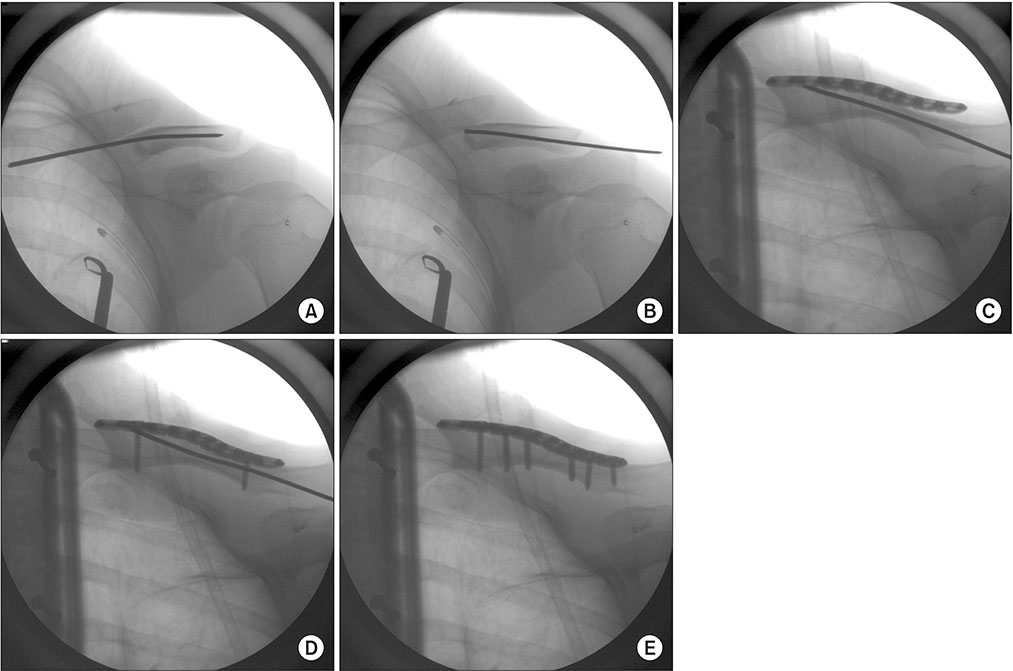J Korean Orthop Assoc.
2018 Aug;53(4):324-331. 10.4055/jkoa.2018.53.4.324.
A Comparison between Open Reduction/Internal Fixation and Minimally Invasive Plate Osteosynthesis Using a 3-Dimensional Printing Model for Displaced Clavicular Fractures
- Affiliations
-
- 1Department of Orthopaedic Surgery, Chungbuk National University Hospital, Cheongju, Korea. hoseungj@gmail.com
- KMID: 2419468
- DOI: http://doi.org/10.4055/jkoa.2018.53.4.324
Abstract
- PURPOSE
This study was performed to compare between open reduction/internal fixation (ORIF) and minimally invasive plate osteosynthesis (MIPO) using a 3-dimensional printing model for displaced clavicular fractures.
MATERIALS AND METHODS
In a retrospective study, we compared the outcomes of 21 patients treated with MIPO (Group A) with those of 22 patients treated with ORIF (Group B) between January 2013 and December 2015. After the operation, bone union was evaluated using X-ray every 4 weeks. The radiologic outcome (bone union), functional outcome (Korean shoulder scale [KSS], The University of California Los Angeles [UCLA] score), scar length, and degree of satisfaction were evaluated.
RESULTS
The mean time to union was 12.1 weeks in Group A and 12.8 weeks in Group B (p=0.524). There was no significant difference in the KSS score and UCLA score between the two groups (p=0.478, p=0.698). The mean length of scar was 4.9 cm (medial 2.6 cm, lateral 2.3 cm) in Group A and 9.7 cm in Group B (p=0.001), and Group A was more satisfied than Group B with respect to scarring (p=0.001). Nonunion developed in one case in each group. Five patients in Group B had skin numbness (1 in Group A, p=0.038).
CONCLUSION
There were no significant differences in the radiologic and functional results between the two groups with respect to displaced clavicle shaft fracture. However, scar satisfaction was higher in MIPO than in ORIF.
MeSH Terms
Figure
Reference
-
1. Nordqvist A, Petersson CJ, Redlund-Johnell I. Mid-clavicle fractures in adults: end result study after conservative treatment. J Orthop Trauma. 1998; 12:572–576.
Article2. Ferran NA, Hodgson P, Vannet N, Williams R, Evans RO. Locked intramedullary fixation vs plating for displaced and shortened mid-shaft clavicle fractures: a randomized clinical trial. J Shoulder Elbow Surg. 2010; 19:783–789.
Article3. Lazarides S, Zafiropoulos G. Conservative treatment of fractures at the middle third of the clavicle: the relevance of shortening and clinical outcome. J Shoulder Elbow Surg. 2006; 15:191–194.
Article4. Omid R, Kidd C, Yi A, Villacis D, White E. Measurement of clavicle fracture shortening using computed tomography and chest radiography. Clin Orthop Surg. 2016; 8:367–372.
Article5. Zlowodzki M, Zelle BA, Cole PA, Jeray K, McKee MD. Evidence-Based Orthopaedic Trauma Working Group. Treatment of acute midshaft clavicle fractures: systematic review of 2144 fractures: on behalf of the Evidence-Based Orthopaedic Trauma Working Group. J Orthop Trauma. 2005; 19:504–507.6. Wenninger JJ Jr, Dannenbaum JH, Branstetter JG, Arrington ED. Comparison of complication rates of intramedullary pin fixation versus plating of midshaft clavicle fractures in an active duty military population. J Surg Orthop Adv. 2013; 22:77–81.
Article7. Frigg A, Rillmann P, Perren T, Gerber M, Ryf C. Intramedullary nailing of clavicular midshaft fractures with the titanium elastic nail: problems and complications. Am J Sports Med. 2009; 37:352–359.8. Sohn HS, Kim WJ, Shon MS. Comparison between open plating versus minimally invasive plate osteosynthesis for acute displaced clavicular shaft fractures. Injury. 2015; 46:1577–1584.
Article9. Jeong HS, Park KJ, Kil KM, et al. Minimally invasive plate osteosynthesis using 3D printing for shaft fractures of clavicles: technical note. Arch Orthop Trauma Surg. 2014; 134:1551–1555.
Article10. Judd DB, Pallis MP, Smith E, Bottoni CR. Acute operative stabilization versus nonoperative management of clavicle fractures. Am J Orthop (Belle Mead NJ). 2009; 38:341–345.11. Ahrens PM, Garlick NI, Barber J, Tims EM. Clavicle Trial Collaborative Group. The clavicle trial: a multicenter randomized controlled trial comparing operative with nonoperative treatment of displaced midshaft clavicle fractures. J Bone Joint Surg Am. 2017; 99:1345–1354.12. Govindasamy R, Kasirajan S, Meleppuram JJ, Thonikadavath F. A retrospective study of titanium elastic stable intramedullary nailing in displaced mid-shaft clavicle fractures. Rev Bras Ortop. 2016; 52:270–277.
Article13. Stark MJ, DeFranco MJ. Elastic intramedullary nailing of a medial clavicle fracture in a pediatric patient. Case Rep Orthop. 2017; 2017:6354284.
Article14. Chen QY, Kou DQ, Cheng XJ, et al. Intramedullary nailing of clavicular midshaft fractures in adults using titanium elastic nail. Chin J Traumatol. 2011; 14:269–276.15. Fuglesang HFS, Flugsrud GB, Randsborg PH, Oord P, Benth JŠ, Utvåg SE. Plate fixation versus intramedullary nailing of completely displaced midshaft fractures of the clavicle: a prospective randomised controlled trial. Bone Joint J. 2017; 99:1095–1101.16. Jung GH, Park CM, Kim JD. Biologic fixation through bridge plating for comminuted shaft fracture of the clavicle: technical aspects and prospective clinical experience with a minimum of 12-month follow-up. Clin Orthop Surg. 2013; 5:327–333.
Article17. Lee HJ, Oh CW, Oh JK, et al. Percutaneous plating for comminuted midshaft fractures of the clavicle: a surgical technique to aid the reduction with nail assistance. Injury. 2013; 44:465–470.
Article18. Sohn HS, Jeon YS, Lee J, Shin SJ. Clinical comparison between open plating and minimally invasive plate osteosynthesis for displaced proximal humeral fractures: a prospective randomized controlled trial. Injury. 2017; 48:1175–1182.
Article19. Aguado HJ, Mingo J, Torres M, Alvarez-Ramos A, Martín-Ferrero MA. Minimally invasive polyaxial locking plate osteosynthesis for 3-4 part proximal humeral fractures: our institutional experience. Injury. 2016; 47:Suppl 3. S22–S28.
Article20. Krettek C, Müller M, Miclau T. Evolution of minimally invasive plate osteosynthesis (MIPO) in the femur. Injury. 2001; 32:Suppl 3. SC14–SC23.
Article
- Full Text Links
- Actions
-
Cited
- CITED
-
- Close
- Share
- Similar articles
-
- Management of Clavicular Shaft Fracture with Open Reduction and Internal Fixation
- The Role of Minimally Invasive Plate Osteosynthesis in Rib Fixation: A Review
- Clinical Results of Surgical Treatment with Minimally Invasive Percutaneous Plate Osteosynthesis for Displaced Intra-articular Fractures of Calcaneus
- Minimally Invasive Percutaneous Plate Fixation for Distal Tibia Shaft Fractures
- Clinical Outcomes of Locking Compression Plate Fixation through Minimally Invasive Percutaneous Plate Osteosynthesis in the Treatment of Distal Tibia Fracture



